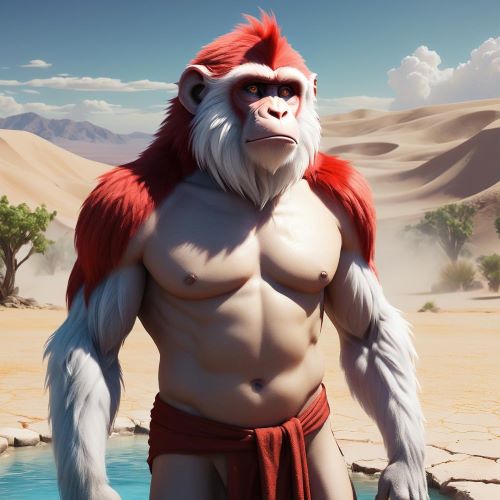Berber Animals
Berber animals in mythology play a significant role in the traditional stories and folklore of the Berber people, an indigenous group from North Africa. These animals are often symbolic figures, embodying qualities such as strength, wisdom, and resilience, and are integral to Berber myths, serving as guides, protectors, or adversaries. The close connection between the Berber people and their environment is reflected in these stories, where animals are revered not only for their physical abilities but also for the spiritual and moral lessons they convey. Their presence in Berber mythology offers insight into the cultural values and beliefs of the Berber people.
Many are seen as spiritual entities, representing natural forces and embodying characteristics that humans can aspire to. For example, lions, which once roamed North Africa, are often depicted as symbols of bravery, leadership, and protection. They are featured in tales as guardians of sacred places or as companions to powerful deities. Similarly, the hawk is a common symbol of vision and freedom, often associated with the sky and the divine. Through these animals, Berber mythology communicates important lessons about courage, independence, and the harmony between humans and nature.
The animals in Berber myths are not only revered for their strength but also for their intelligence and cunning. The fox, for instance, is a recurring character in Berber stories, often depicted as a trickster figure. It uses its cleverness to outwit larger, stronger animals or even humans, teaching lessons about resourcefulness and adaptability. In this way, they are more than just representations of physical power; they also reflect the importance of wit and mental agility in overcoming challenges. This duality of strength and intelligence is a key theme in Berber folklore, emphasizing the balance between physical prowess and wisdom.
In addition to their symbolic roles, Berber animals often play practical roles in rituals and cultural practices. Many animals are associated with specific traditions or ceremonies, particularly those connected to the seasons, fertility, and protection. For example, the ram is a prominent figure in Berber rituals related to sacrifice and fertility, representing renewal and the cycle of life. These animals are not just characters in stories but are also revered in religious and spiritual contexts, underscoring their significance in both the physical and spiritual realms of Berber life.
Today, the legacy of Berber animals in mythology continues to influence Berber culture and identity. Although modern life has changed many aspects of traditional Berber society, the symbolic meanings of these animals persist in art, music, and literature. They continue to be celebrated as emblems of the Berber people’s resilience, connection to nature, and spiritual beliefs. Whether in ancient myths or contemporary expressions, Berber animals remain a powerful symbol of the deep bond between humans, nature, and the divine.
Berber animals in mythology play a significant role in the traditional stories and folklore of the Berber people, an indigenous group from North Africa. These animals are often symbolic figures, embodying qualities such as strength, wisdom, and resilience, and are integral to Berber myths, serving as guides, protectors, or adversaries. The close connection between the Berber people and their environment is reflected in these stories, where animals are revered not only for their physical abilities but also for the spiritual and moral lessons they convey. Their presence in Berber mythology offers insight into the cultural values and beliefs of the Berber people.
Many are seen as spiritual entities, representing natural forces and embodying characteristics that humans can aspire to. For example, lions, which once roamed North Africa, are often depicted as symbols of bravery, leadership, and protection. They are featured in tales as guardians of sacred places or as companions to powerful deities. Similarly, the hawk is a common symbol of vision and freedom, often associated with the sky and the divine. Through these animals, Berber mythology communicates important lessons about courage, independence, and the harmony between humans and nature.
The animals in Berber myths are not only revered for their strength but also for their intelligence and cunning. The fox, for instance, is a recurring character in Berber stories, often depicted as a trickster figure. It uses its cleverness to outwit larger, stronger animals or even humans, teaching lessons about resourcefulness and adaptability. In this way, they are more than just representations of physical power; they also reflect the importance of wit and mental agility in overcoming challenges. This duality of strength and intelligence is a key theme in Berber folklore, emphasizing the balance between physical prowess and wisdom.
In addition to their symbolic roles, Berber animals often play practical roles in rituals and cultural practices. Many animals are associated with specific traditions or ceremonies, particularly those connected to the seasons, fertility, and protection. For example, the ram is a prominent figure in Berber rituals related to sacrifice and fertility, representing renewal and the cycle of life. These animals are not just characters in stories but are also revered in religious and spiritual contexts, underscoring their significance in both the physical and spiritual realms of Berber life.
Today, the legacy of Berber animals in mythology continues to influence Berber culture and identity. Although modern life has changed many aspects of traditional Berber society, the symbolic meanings of these animals persist in art, music, and literature. They continue to be celebrated as emblems of the Berber people’s resilience, connection to nature, and spiritual beliefs. Whether in ancient myths or contemporary expressions, Berber animals remain a powerful symbol of the deep bond between humans, nature, and the divine.


